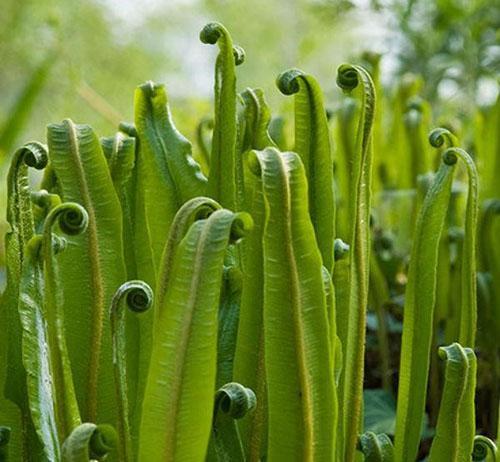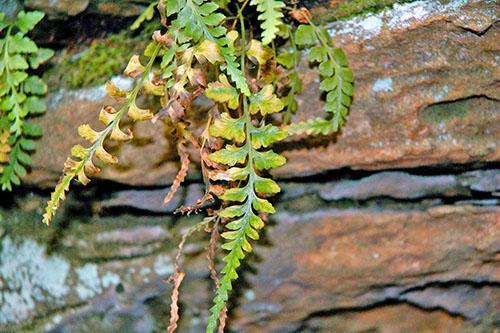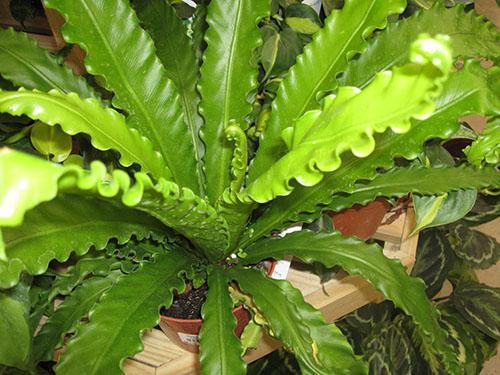Photo of asplenium diseases and plant care
 The extensive Konstantsov family includes many species of ferns with a common name - Aspleniums. Growing both in the tropical zone and the temperate climate of Europe and Asia, these plants can lead a terrestrial and rocky lifestyle. There are aspleniums and epiphytes.
The extensive Konstantsov family includes many species of ferns with a common name - Aspleniums. Growing both in the tropical zone and the temperate climate of Europe and Asia, these plants can lead a terrestrial and rocky lifestyle. There are aspleniums and epiphytes.
Not the largest, but the most attractive and unusual aspleniums are grown as indoor ornamental deciduous plants. At the same time, the good growth of the fern and its beauty directly depend on the care and conditions in which the plants are located.
In nature, ferns prefer to settle in places where they are guaranteed protection from the sun's rays, there is a little loose substrate and moisture. It would seem that with such modest requirements in an apartment, these plants should be absolutely comfortable. But sometimes flower growers face a number of serious problems.

Most of the fern diseases are associated with a violation of their keeping conditions or improperly organized care.
Asplenium stopped growing: causes and solutions to the problem
 So how do you please the plants? Most often, several varieties of asplenium can be found on window sills. Among the large rosette forms with solid or slightly dissected foliage, these are:
So how do you please the plants? Most often, several varieties of asplenium can be found on window sills. Among the large rosette forms with solid or slightly dissected foliage, these are:
- asplenium nidus, which grows wild in the tropical zone of the planet;
- ancient asplenium, also living under the canopy of a moist dense forest in the tropics;
- asplenium centipede, which is a European and American forest species.
Ferns from this family with feathery and almost filamentous foliage are:
- asplenium onion-bearing;
- asplenium is viviparous.
 Lovers of indoor floriculture grow other species ferns, but they are all extremely sensitive to lighting conditions, temperature and humidity. When caring for asplenium, in the photo, take into account that plants are shade-loving and do not tolerate too bright light. The first reaction of the fern to an excess of the sun is the blanching of the leaves, and then the plant responds to the unwanted exposure to sunlight with brown spots on the fronds, their gradual wilting and dying off.
Lovers of indoor floriculture grow other species ferns, but they are all extremely sensitive to lighting conditions, temperature and humidity. When caring for asplenium, in the photo, take into account that plants are shade-loving and do not tolerate too bright light. The first reaction of the fern to an excess of the sun is the blanching of the leaves, and then the plant responds to the unwanted exposure to sunlight with brown spots on the fronds, their gradual wilting and dying off.
Dryness of the air is equally sensitive to aspleniums, especially noticeable in winter, when the premises are heated, as well as on hot summer days. Dry air causes the asplenium to stop growing, its old leaves begin to dry out, and new ones do not appear at all.
If a florist is faced with such a situation, it is necessary to take all measures to humidify the air.
 And here a good help in caring for asplenium will be:
And here a good help in caring for asplenium will be:
- irrigation of the aboveground part of the fern with warm water;
- using a household humidifier;
- installing a pot with asplenium in a pallet with moistened gravel or fine expanded clay.
When the tips of asplenium leaves begin to dry, treatment consists in increasing the air humidity to 60-65% and adjusting watering regime... Soon you can see that the growth of the fern has resumed, and necrosis does not capture new frond tissues.
In a room with low air humidity, the plant will be comfortable only if the temperature does not rise above 22 ° C.
In summer, for shade-tolerant ferns, you need to find a place where the average daily temperature was in the range of 18-21 ° C, while in winter the air can be 3-5 degrees cooler.
 Moreover, at any time of the year, the fern should not be allowed to be in the cold. For tropical and feathery leaves, the critical temperature is 10–12 ° C. Plunging into suspended animation, the asplenium stops growing, but the reason is that in such cold air, the roots of the plant stop absorbing moisture. And with a long stay in cold, moist soil, the fern rhizome inevitably rots. Spraying foliage at low temperatures is also not beneficial.
Moreover, at any time of the year, the fern should not be allowed to be in the cold. For tropical and feathery leaves, the critical temperature is 10–12 ° C. Plunging into suspended animation, the asplenium stops growing, but the reason is that in such cold air, the roots of the plant stop absorbing moisture. And with a long stay in cold, moist soil, the fern rhizome inevitably rots. Spraying foliage at low temperatures is also not beneficial.
Errors when leaving, watering and feeding asplenium
 Therefore, in addition to maintaining a comfortable air temperature and humidity, the fern needs regular, but not excessive watering.
Therefore, in addition to maintaining a comfortable air temperature and humidity, the fern needs regular, but not excessive watering.
Dry air, a violation of the temperature regime and illiterate watering are not the only reasons why leaves turn pale or turn brown on Asplenium.
Often, spots on fern fronds are a sign of improper use of fertilizers, as well as an attack by insects, causing the weakening and sometimes death of the fern.
The substrate should not be allowed to dry out, but excessive soil moisture is no less dangerous. Watering is combined with dressings, which are carried out in the summer after 10-14 days.
Leaving the fern without watering, the florist risks that due to a lack of moisture, the leaves of the asplenium will turn yellow and die off. In this case, you should not hesitate, because even with a complete loss of the aerial part, a viable rhizome still remains. If you take timely measures to resuscitate the asplenium, the fern can still be saved.
 All yellowed or dried leaves are removed from the outlet, the rhizome is transferred to fresh soil and gently watered and sprayed on the fern. The remaining dormant leaf rudiments wake up within 10-15 days, as evidenced by the appearance of first brown and then green buds in the middle of the rosette.
All yellowed or dried leaves are removed from the outlet, the rhizome is transferred to fresh soil and gently watered and sprayed on the fern. The remaining dormant leaf rudiments wake up within 10-15 days, as evidenced by the appearance of first brown and then green buds in the middle of the rosette.
As a substrate for asplenium, you can take:
- ready-made soil for ferns, after adding a little vermiculite and ground charcoal to it,
- soil for orchids and epiphytes, mixed with a small amount of nutrient soil and vermiculite;
- homemade mixture of peat, leafy earth and humus with the addition of pieces of charcoal, perlite and chopped sphagnum.
 During transplantation, it is necessary to carefully examine the roots of the asplenium, and if dry or rotten is found, be sure to remove it. Healthy rhizomes are brownish, dense, covered with scales. Blackening of the rhizome tissue and its thinning can be considered a sign of the disease.
During transplantation, it is necessary to carefully examine the roots of the asplenium, and if dry or rotten is found, be sure to remove it. Healthy rhizomes are brownish, dense, covered with scales. Blackening of the rhizome tissue and its thinning can be considered a sign of the disease.
To prevent the cut points from rotting, they are treated with ground cinnamon, which has mild bactericidal properties, or charcoal powder.
Asplenium diseases and pests in the photo and in the descriptions
 Ferns at home rarely suffer from any diseases, but neglecting the care necessary for the asplenium depicted in the photo, you can face infections of a bacterial and fungal nature.
Ferns at home rarely suffer from any diseases, but neglecting the care necessary for the asplenium depicted in the photo, you can face infections of a bacterial and fungal nature.
The most common diseases of asplenium are root and stem rot, which is possible if irrigation rules are violated, as well as leaf bacteriosis, as a result of which fronds lose their juiciness and strength, and then quickly die.
 Violation of plant care leads, as in the photo, to asplenium diseases associated with the reproduction of harmful fungi of the Phyllosticta species.
Violation of plant care leads, as in the photo, to asplenium diseases associated with the reproduction of harmful fungi of the Phyllosticta species.
Outwardly, the disease manifests itself in the form of oval or shapeless, rapidly expanding spots on the leaf plates. First, the leaf tissue acquires a yellow tint, then turns brown and dies off, leaving growing holes on the leaf plates. This is how the disease looks on the nest-like asplenium, on the feathery crown of other species the leaves turn yellow and die off, very quickly leading to the complete loss of the plant.In this case, the disease can be recognized by a dark bloom on the back of the affected leaf and the rapid destruction of dried tissue.
You can get rid of fungal infections:
- cutting off all affected parts of the plant;
- several times by treating the crown and soil with a fungicide.
 As a preventive measure for such diseases, it is imperative to remove all dry leaves and establish watering and asplenium care, as in the photo.
As a preventive measure for such diseases, it is imperative to remove all dry leaves and establish watering and asplenium care, as in the photo.
 If the leaves turn pale, starting from the central vein, and dry up even with proper care of the plant, a fern lover should think about the defeat of the pet by a leaf nematode that has entered the plant from the ground. Unfortunately, such an asplenium can hardly be helped, so it is better to part with the fern, and steam the soil and the pot thoroughly.
If the leaves turn pale, starting from the central vein, and dry up even with proper care of the plant, a fern lover should think about the defeat of the pet by a leaf nematode that has entered the plant from the ground. Unfortunately, such an asplenium can hardly be helped, so it is better to part with the fern, and steam the soil and the pot thoroughly.
 The rest of the pests, in the photo, asplenium, like diseases, can be defeated. Insects affecting ferns include scale insects, mealybugs and fern aphids.
The rest of the pests, in the photo, asplenium, like diseases, can be defeated. Insects affecting ferns include scale insects, mealybugs and fern aphids.
 If the plant is constantly kept in moist soil, mushroom mosquitoes and thrips cannot be avoided. Treatment of asplenium from such pests necessarily includes treatment with an insecticide, elimination of the cause that made it possible to weaken the plant and establishment of care.
If the plant is constantly kept in moist soil, mushroom mosquitoes and thrips cannot be avoided. Treatment of asplenium from such pests necessarily includes treatment with an insecticide, elimination of the cause that made it possible to weaken the plant and establishment of care.